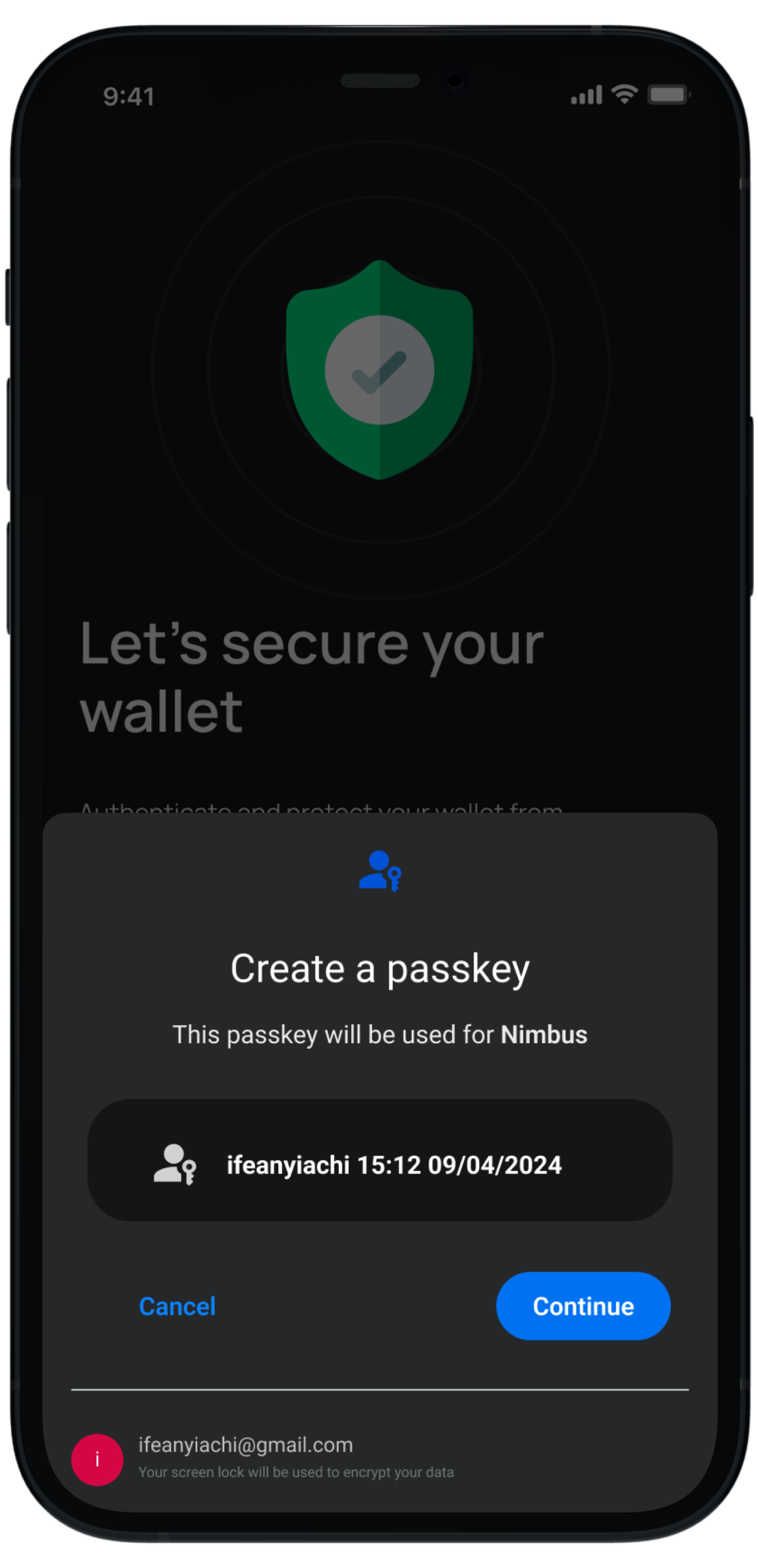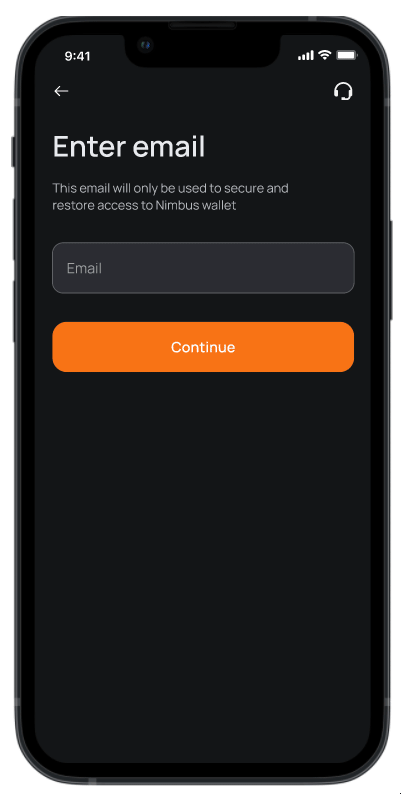Simplifying web3 with familiar UX and secure design
New users in the DeFi ecosystem currently face significant onboarding challenges due to inadequate security practices and poor user experience design. These issues lead to a high risk of financial loss and decreased trust in the ecosystem, significantly impacting the success of user adoption.
By leveraging Multi-Party Computation (MPC) technology and traditional fintech UX, Nimbus simplifies the onboarding process for new users, making it simple for them to explore DeFi ecosystem
My primary goal in this study was to minimize user friction, improve sense of security, and create a reliable, accessible environment for our core users.
Nimbus is a user-friendly, non-custodial wallet designed for the Solana blockchain. It allows users to securely store, manage, and stake Solana (SOL) tokens, interact with decentralized apps (dApps), and participate in DeFi activities
- Role: Product Designer , User Researcher
- Theteam: Solo
- Year: 2023

"How could this happen"?
My friend, Frank recently lost the $400 he earned from his first airdrop. As a crypto newbie, he received a Notcoin $NOT airdrop and decided to explore more of telegram miniapps. He soon started trading tokens on Solana blockchain and made some profit trading $Mother and $Daddy tokens, which further increased his interest in decentralized finance.
Unfortunately, after formatting his phone, he discovered that his notepad app—where he had stored his seed phrases—hadn’t been synced to the cloud. Additionally, his fellow newbie friends faced various challenges, highlighting the challenges and gaps that makes current web3 usage a hassle
Clarifying patterns through research
To gain a clearer understanding of the various issues at hand, I decided to conduct user research that included both one-on-one interviews and secondary research. The user interviews were carried out with two distinct groups: crypto newcomers with less than one year of experience and those with at least two years of experience. Below is an image outlining the criteria I developed for participant selection.

Having completed my research, I analyzed and sorted the data garnered and discovered common but key insights on participant’s pain points, current challenges and also crucial areas for improvements and opportunities.

Persona Insights and benchmarking
I developed a user persona to gain a detailed understanding of our core users’ needs and wants. Additionally, I conducted secondary research to gather insights from external sources such as community feedback and expert opinions, focusing on how user behavior impacts user experience, user satisfaction and adoption rates. This research revealed key trends in user preferences, which allowed me to reframe the challenges into opportunities by crafting ‘How Might We’ (HMW) question
How might we make each part of the user journey familiar and DeFi experience less intimidating
Adoption of Web2-Like Interfaces
Newer crypto wallets are adopting web2-like user interfaces to make the experience familiar and less intimidating for new users. A major advantage of this approach is bridging the gap between traditional web experiences and web3, making onboarding smoother for those less familiar with DeFi
Focus on Security Without Sacrificing Usability
There's an increasing emphasis on balancing security features with user-friendliness. Newer wallets are exploring alternative onboarding approach, ultimately making web3 more accessible and easier to understand for the average user
Cross-Chain Interoperability
Users want to be able to manage assets across multiple blockchains within a single wallet, reducing the complexity of managing multiple wallets or navigating between different platforms
Let's start with User onboarding
In web2 especially financial products, a user would have to create an account, and go through some KYC process before making any transactions. Web3, however, offers a completely different experience. All you have to do is open a DeFi wallet, save your seed phrase, and you’re all set for your next transaction.
What I did was introduce an account creation process, but it’s only used to store wallet details like addresses and seed phrases; and also to restore access to Nimbus wallet
Web3 wallet addresses function like account numbers in traditional financial products. The only problem? You can’t memorize them. These addresses are long alphanumeric strings, usually 42 characters, that uniquely identify a user’s account on the blockchain.
To make things easier, we integrated the Solana Name Service, enabling our users to create simple, user-friendly, and shareable addresses.


Web3 wallet addresses function like account numbers in traditional financial products. The only problem? You can’t memorize them. These addresses are long alphanumeric strings, usually 42 characters, that uniquely identify a user’s account on the blockchain.
To make things easier, we integrated the Solana Name Service, enabling our users to create simple, user-friendly, and shareable addresses.

A major pain point during onboarding was the hassle of securely storing seed phrases. Taking a cue from Web2 practices, we simplified this by eliminating the need for manual seed phrase storage. Instead, users are required to back up their wallets directly to their cloud drive




Putting it all together to build a secure wallet that anyone can open in less than 4 minutes
By addressing each core user challenge, I crafted an onboarding experience that balances security with ease of use. Features like cloud-based seed phrase backup and simplified wallet addresses not only streamline the process but also foster user confidence and trust, making Web3 more accessible to everyday users

A wallet dashboard that works


Broader validator choices, clearer rewards

Powerful virtual cards for effortless online payments
Integrating virtual cards into the Web3 wallet meets a vital need for users looking to make online payments with their cryptocurrency. I streamlined the card creation and usage process, making it feel more intuitive and familiar, akin to a Web2 experience

A whole new world of Defi
With DeFi, users can access decentralized services such as yield farming, borrowing, and lending without the need for traditional banks, opening up possibilities for financial freedom. This gives users the ability to actively manage their assets, engage in peer-to-peer transactions, and look into innovative ways to create more value

Usability study
I conducted a usability study to assess if users could seamlessly navigate and adopt Nimbus’s onboarding process. The study focused on ease of use, the complexity of setting up a wallet, and users’ overall perceptions of the experience.
-
85% of participants (17/20) completed the wallet setup without additional support.
-
95% of participants felt confident in the security provided by the cloud backup feature
-
2 participants mentioned minor confusion during onboarding, related to wallet address creation
-
80% of users rated the app as highly intuitive
-
15% reported that they would like more visual aids or explanations during the setup
I did some benchmarking study and found out some areas where we could offer users additional flexibility
-
I didn't consider the importance of memos in certain use cases. Some tokens require specific comments or codes during transfers; failing to include them can result in a loss of funds
-
An option to view and export seedphrases manually so users can transact with their wallet outside the Nimbus app
Key lessons
Simplicity is key
Users overwhelmingly commended the streamlined wallet setup and easy cloud backup for seed phrases. We realized that minimizing steps and complexity significantly improves user confidence and adoption, particularly among first time users
Security without overload
Users want security measures that are subtle but effective, even if security is crucial. The cloud backup option for seed phrases offered peace of mind without burdening users with manually storing them
Users value familiarity
Drawing inspiration from Web2 practices proved beneficial, as users were more comfortable navigating a familiar interface. By making elements like account creation and cloud backups more recognizable, we increased overall usability
